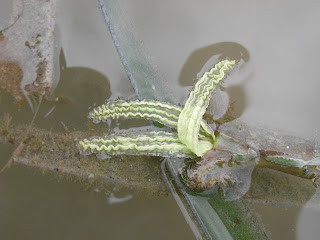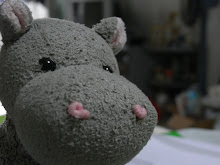 Here are the tools of the 'trade' (clockwise from left): ruler, transect tape, clipboard with recording sheet, ID chart and quadrat. We grouped ourselves into team of threes. Gerald, Samuel and I worked together :)
Here are the tools of the 'trade' (clockwise from left): ruler, transect tape, clipboard with recording sheet, ID chart and quadrat. We grouped ourselves into team of threes. Gerald, Samuel and I worked together :) At the perimeter of the seagrass meadow, Gerald sighted a Blue-spotted Fantail Ray (Taeniura lymma) hiding among the seagrass.
At the perimeter of the seagrass meadow, Gerald sighted a Blue-spotted Fantail Ray (Taeniura lymma) hiding among the seagrass.
Some blades of seagrass had ascidians on them. Note that ascidians are not plants but animals! They are vertebrates and belong to the Phylum Chordata (like us!). These are affectionately known as Green Gum Drops Ascidians, and are colonial. The seagrass also has quite a lot of epiphyte (a kind of tiny algae) cover, giving it a dirty appearance.

This is the female flower of the Tape Seagrass (Enhalus acoroides).
 Among the seagrass, there were many small bunches of this red algae (Gracilaria sp.). [Edit]
Among the seagrass, there were many small bunches of this red algae (Gracilaria sp.). [Edit] Drifting lazily on the surface of the water and blown about by gusts of wind were the tiny white male flowers of the Tape Seagrass (Enhalus acoroides).
Drifting lazily on the surface of the water and blown about by gusts of wind were the tiny white male flowers of the Tape Seagrass (Enhalus acoroides). Blue corals (Heliopora coerulea) in the seagrass meadow! Note that these may appear to be hard corals, but they are actually soft corals. Edit: These may actually be Green Gum Drops Ascidians too as suggested by Ria. Thanks!
Blue corals (Heliopora coerulea) in the seagrass meadow! Note that these may appear to be hard corals, but they are actually soft corals. Edit: These may actually be Green Gum Drops Ascidians too as suggested by Ria. Thanks! Woohoo! My first time seeing a Knobbly Sea Star (Protoreaster Nodosus) on Semakau.
Woohoo! My first time seeing a Knobbly Sea Star (Protoreaster Nodosus) on Semakau. If quickly flipped over, one will be able to see its tube feet waving about as well as the protruding muscle-like mass which is its stomach.
If quickly flipped over, one will be able to see its tube feet waving about as well as the protruding muscle-like mass which is its stomach. This pic looks familiar, right? It was my first header!
This pic looks familiar, right? It was my first header! Check out the intricate detail on the Knobbly's body. Simply amazing.
Check out the intricate detail on the Knobbly's body. Simply amazing. This tentacle-waving anemone (probably a Wiggly Star Anemone) is very shy indeed. It quickly retracted its tentacles and ducked away (methinks it is motile) when I approached it. Had to wait for a little while before it felt comfortable enough to venture out again.
This tentacle-waving anemone (probably a Wiggly Star Anemone) is very shy indeed. It quickly retracted its tentacles and ducked away (methinks it is motile) when I approached it. Had to wait for a little while before it felt comfortable enough to venture out again. Some more anemones nearby. These had bright greenish-yellow tentacles, and were about 1-2 cm in diameter. I've no clue as to what kind of species they might be. Edit: These are probably zoanthids (Order Zoanthidea) instead! They are commonly confused with sea anemones (Order Actiniaria) as they look similar. However, "while sea anemones are solitary polyps, most zoanthids live in colonies like corals do.". They also have a different make-up from corals. Thanks Ria!
Some more anemones nearby. These had bright greenish-yellow tentacles, and were about 1-2 cm in diameter. I've no clue as to what kind of species they might be. Edit: These are probably zoanthids (Order Zoanthidea) instead! They are commonly confused with sea anemones (Order Actiniaria) as they look similar. However, "while sea anemones are solitary polyps, most zoanthids live in colonies like corals do.". They also have a different make-up from corals. Thanks Ria! The first time I saw a cowrie was on Sultan Shoal. This appears to be an Arabian Cowrie (Cypraea arabica) with its mantle covering its shell. When the mantle is retracted, the shell is glossy and smooth. Edit: This is NOT an Arabian Cowrie as I previously thought. The Arabian Cowrie has brown spots on the outer edges (the lighter part of the shell, in this photo) which the cowrie here clearly does not have. So it's probably either a Wandering Cowrie (Cypraea errones) or an Ovum Cowrie (Cypraea ovum). [Refer to Ron's comment]
The first time I saw a cowrie was on Sultan Shoal. This appears to be an Arabian Cowrie (Cypraea arabica) with its mantle covering its shell. When the mantle is retracted, the shell is glossy and smooth. Edit: This is NOT an Arabian Cowrie as I previously thought. The Arabian Cowrie has brown spots on the outer edges (the lighter part of the shell, in this photo) which the cowrie here clearly does not have. So it's probably either a Wandering Cowrie (Cypraea errones) or an Ovum Cowrie (Cypraea ovum). [Refer to Ron's comment]
A Spotted Black Flatworm (Acanthozoon sp.) swimming away.





Having been to Semakau twice already, I nevertheless look forward to the next trip. Each trip never fails to bring pleasant surprises (Knobbly Sea Stars, yay!). In due course, I hope that my photography skills will improve and more importantly, I'll be able to spot and identify more organisms. Glad to have met many new friends in Project Semakau as well :)



The cowrie is either a ovum or wandering cowrie, but definitely not an arabica.
ReplyDelete